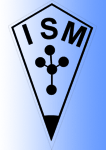|
|
SCIENTIFIC RESULTS
1961-2011
- The formation of two- and three-element superhard structures (˝BC2N, MgB2, MgB12, AlMgB14, etc.) at superhigh pressures and temperatures has been substantiated.
- Diamond single crystals with semiconducting properties, including the conductivity of a metal type are synthesized due to controlled doping and distribution of boron and nitrogen impurities in the bulk of a crystal. The crystal electrophysical and electronic properties are investigated; the mechanisms of conductivity are defined.
- The exact values of elastic moduli, compression strength, fracture toughness of diamond and cBN crystals and polycrystals are defined.
- The conditions for the adhesion contact of glass-ceramic coatings and grains are understood
- Micron, submicron and nanopowders of diamond are produced.
- The regularities are determined of capillary processes in carbon and BN solutions in melts of metals and their nitrides resulting in the formation of centres of diamond and cBN crystallization and growth at high pressure, the thermodynamics of the crystallization process is investigated, phase diagrams of multicomponent systems at high pressures are constructed.
- The regularities of the formation of structured composites with diamond and cBN grains as fillers in metal, glass ceramic, and rubber polymeric matrices are determined. .
- The scientific fundamentals are advanced of controlling physicochemical processes of restoration, carburization, and growth of perfect monocrystals of carbides (WC and TiĐ) and obtaining solid solutions of these carbides, their interaction with diamond and cBN; optimum structure formation in layered and gradient materials based on hard alloys; the use of precision-controlled gas atmosphere. A new technological equipment has been created and manufactured..
- The processes of electric, chemical, and mechanical fracture of materials processed with diamond and cBN tools have been studied.
- The regularities of wear and destruction of contact diamond and cBN grains on various bonds, in abrasive machining of metal (steel, titanium, aluminum) and nonmetal (ceramics, glass, composites) materials are explored.
- The formation of diamond-retaining metal coatings in processes of galvanoplastics and electroplating are analyzed.
- The possibility to accelerate the seed-growth of carbon in crystallization of large diamond crystals both colorless and variously colored using the temperature gradient method is established.
- The regularities of the fracture mechanics of diamond-containing composites with hard alloy and metal matrices are defined and the composite strength, wear, and fracture toughness characteristics at static and dynamic loads are analyzed.
- Principles are advanced of thermomechanics of the low-cycle deformation and evaluation of the limiting state with a numerical calculation of the distribution of mechanical and thermal stresses in multianvil high-pressure apparatuses from materials with different moduli in a wide range of heating temperatures.
- The theory of thermomechanics is developed for the description of graphite into diamond phase transition by numerical computer modeling with allowance made for variations of characteristics of materials with different moduli of a reaction mixture at high pressures and temperatures in the course of diamond crystallization from a melt under superhigh pressure is developed.
- The problems of thermomechanics of contact interaction in diamond microturning of aluminum and in turning coatings, facings, and various intricate workpieces by cBN cutters are solved.
- A modern analytical centre of a research and diagnostics of structure and physicochemical properties of materials with a possibility to analyze structural, elemental, disperse and isotope compositions of the surface and near-surface layers on a nanolevel is organized. The procedures are developed and new equipment is manufactured for in situ study of phase transitions in materials under the action of superhigh pressures and shear strains in diamond anvils; determining the state of conductive surface by scanning tunnel microscopy with use of diamond semiconducting nanoindenters, and for the high-temperature thermal analysis under high pressure are developed. The center of certification of high-strength superhard materials and tools based on them includes a diamond test laboratory to execute the expertise of superhard materials and tools, and is accredited in the Ukrsepro system of certification.
- The mechanism of the influence of high pressures and temperatures on a structure, superconducting and mechanical properties of high-temperature ceramic superconductors, the formation of superconducting junctions are examined.
Main page
|
|







